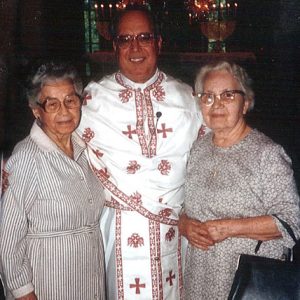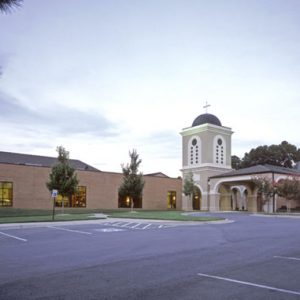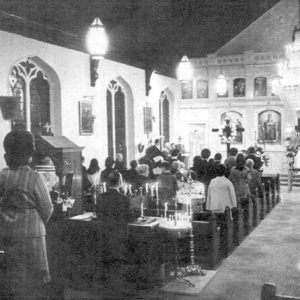calsfoundation@cals.org
Greek Orthodox
The ancient Christian Greek Orthodox Church claims a founding by Jesus Christ and his apostles, as described in the Book of Acts in the Bible, along with a claim to an unbroken historical existence. Orthodox Christianity endeavors to lead all peoples of all nationalities toward a dynamic spiritual relationship with the Father, the Son, and the Holy Spirit. Arkansas has an estimated 2,000 Greek Orthodox Christians, out of a total 1.5 million in the United States and approximately 300 million worldwide.
The teachings of Orthodoxy are described in the Nicene Creed, adopted in AD 325 by an ecumenical council: belief in one God, creator of all things, and his Son, Jesus Christ, who was crucified for the world’s salvation and was resurrected on the third day, and who will come again in glory to judge the living and the dead and establish his kingdom forever. As Trinitarians, the Orthodox believe the Holy Spirit is the giver of life and is worshiped along with the Father and the Son. They acknowledge one baptism for the remission of sins and expect that the dead will be resurrected.
The Orthodox Church is hierarchical, i.e., it has patriarchs, metropolitans, archbishops, bishops, and both married and celibate priests. The Holy Synod in New York is the ecclesiastical instrument of governance of the archdiocese and is composed of the archbishop as president, and the eight metropolitans in the United States as the members. The synod is responsible for dogmatic and canonical matters. The Clergy-Laity Congress, which is made up of all clergy and elected lay delegates in the archdiocese, is concerned with matters that affect the life, mission, growth, and unity of the archdiocese, and is the legislative instrument of governance. The appointed Archdiocesan Council is an advisory and consultative body to the archbishop and the synod as well as interim decision-making body (except for dogmatic and canonical matters) between the biennial clergy-laity congresses. Each priest is the spiritual shepherd of his parish and is assisted by an elected parish council.
Orthodoxy is one Christian denomination with identical beliefs; the only significant difference is the liturgical language. When Greek, Russian, or other immigrants came to America, they came from countries where they lived under occupation or repressive regimes. Therefore, the Orthodox Church was not free to have a cohesive missionary effort here originally, so Orthodox churches were founded individually by groups of immigrants from various countries. Today, however, Orthodox parishes comprise descendants of the immigrants, as well as many converts, and in Arkansas, English is the principal liturgical language.
In Arkansas, the Greek Orthodox Church arrived with the first Greek immigrants in the late nineteenth century. When the Orthodox community in the Little Rock (Pulaski County) area became large enough, in about 1905, a group of immigrants created the cultural and religious Homer Society. At first, visiting priests from Memphis, Tennessee, were invited to celebrate the Divine Liturgy and perform sacraments. In 1913, members arranged for a permanent priest, Father Kallinikos Kanellas, and services were held in an upstairs meeting hall over a grocery store near 9th and Main streets for the next eight years. A small chapel was arranged for liturgies and sacraments, and another area was used for social gatherings. Research by Reverend Father George Scoulas in the 1960s indicated that Kanellas probably was the first Orthodox priest of Greek ancestry to come to the United States. He died in 1921 and is buried in the historic Oakland Cemetery in Little Rock, where most of the early Greek immigrants were interred. Early church leaders included P. G. Johnson, Pelopida (Peter) Kumpuris, Joe Stathakis, Anastasios Stathakis, Peter Stathakis, George Lianos, Basil Peters, Sam Stathakis, George Stathakis, and Harry Hronas.
According to the Arkansas Democrat magazine section of January 27, 1952, the first Orthodox church in Arkansas was the Russian Orthodox church in Slovak (Prairie County). The community dates to about 1894 with the settlement of Slovaks, and apparently two Russian Orthodox priests founded the church at the same time. As late as about 1940, the Russian Orthodox Church in America still listed it, but they appear to have had no resident clergy. Annunciation in Little Rock is the oldest continuous Orthodox church in Arkansas.
The parish of the Annunciation, under the jurisdiction of the Metropolitan of Detroit, the Greek Orthodox Archdiocese of North America, and the Ecumenical Patriarch in Constantinople (now Istanbul), Turkey, received a state charter on June 8, 1920, and a church building at 1500 Center Street was purchased from the Winfield Methodist congregation in 1919. The parish outgrew this building, and in 1983, a new church was constructed at its present location, 1100 Napa Valley Drive. Dr. James Pappas served as chairman of the Building/Finance Committee, Gus Vratsinas was president of the Parish Council, and Reverend Father Pierre Delfos was pastor at the time.
The parish of Zoodochos Peghee, the Life-Giving Water (St. Mary’s), was built in Hot Springs (Garland County) in the 1950s and dedicated on January 30, 1960. The parish had eighteen families at the time. St. George, a mission parish for those living in the Fort Smith (Sebastian County) area, was established in the 1950s and later was continued by the Orthodox Church in America (Russian—OCA). For a time, one priest served the Fort Smith and Hot Springs parishes. Orthodox who lived in Pine Bluff (Jefferson County), Malvern (Hot Spring County), El Dorado (Union County), and Camden (Ouachita County) attended church services in Little Rock when they could, as did the Hot Springs families, until their church was completed in 1960. A Shreveport, Louisiana, parish served families living in Texarkana (Miller County). In the 1990s, the Antiochian Orthodox Archdiocese established a mission in Little Rock, the Holy Trinity Orthodox Church, and another mission in Fayetteville (Washington County), out of which grew St. Nicholas Orthodox Christian Church in Springdale (Washington and Benton counties); its church building, designed by architect Marlon Blackwell, was completed in 2010.
In 2006, Annunciation parish in Little Rock had about 250 members, about thirty percent of whom are of Greek ancestry. About the same percentage had emigrated from countries such as Palestine, Lebanon, Iraq, Egypt, and Syria or are descended from such immigrants. Several were from Russia, Ukraine, Georgia, Romania, and other countries formerly behind the Iron Curtain, and a few families were from India and Nigeria. The rest were local converts to Orthodoxy.
Since 1984, Annunciation has become known in Arkansas for its annual Greek Food Festival, held on the church grounds. Proceeds of the festival are shared with local charities each year. It is an opportunity, too, for the parishioners to share their various cultures with Arkansans. Since 2001, Annunciation has hosted an annual golf tournament with Easter Seals of Arkansas. The Greek Folklore Society was organized in 1989 to promote Greek folk dancing and to perform at the festival. A college scholarship program for Annunciation youths was established in 1989. Youth and Sunday school programs are active, as is the ladies auxiliary, the Philoptochos (friends of the poor). Annunciation has the greatest collection of original Byzantine icons in the state, and church tours are a part of the annual festival. The iconography is used as a visual teaching aid, which honors the great men and women of the faith by remembering and revering them but is not an object of worship.
For additional information:
Annunciation Greek Orthodox Church. https://orthodoxchurch.com/ (accessed October 18, 2023).
Earl, Jack. “Little Slovakia in Arkansas.” Arkansas Democrat Sunday Magazine. January 27, 1952, pp. 1–2.
Elfter, James G. “History of Zoodochos Peghee.” The Record 7 (1966): 88–90.
Hronas, James, and Helen Hronas. “A History of the Annunciation Greek Orthodox Community of Little Rock, Arkansas.” Pulaski County Historical Review 39 (Fall 1991): 61–67.
Helen R. Hronas
Little Rock, Arkansas

 Pierre Delfos
Pierre Delfos  Greek Orthodox Church
Greek Orthodox Church  Greek Orthodox Church
Greek Orthodox Church 



Comments
No comments on this entry yet.